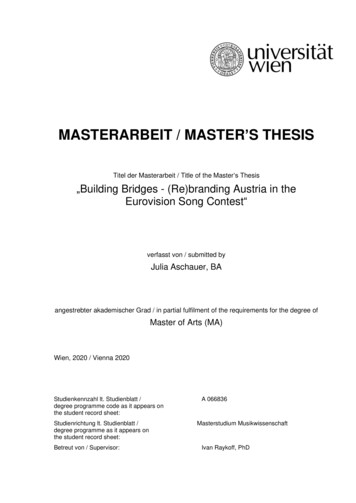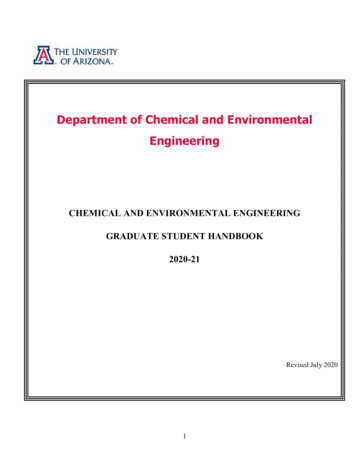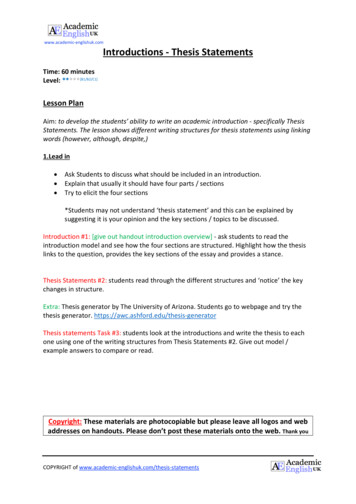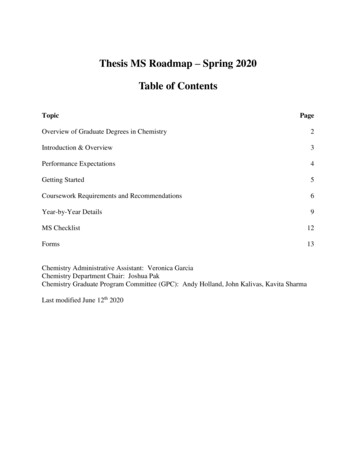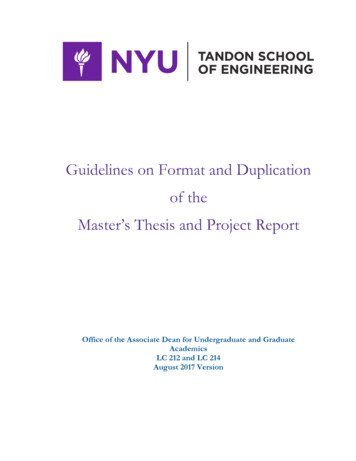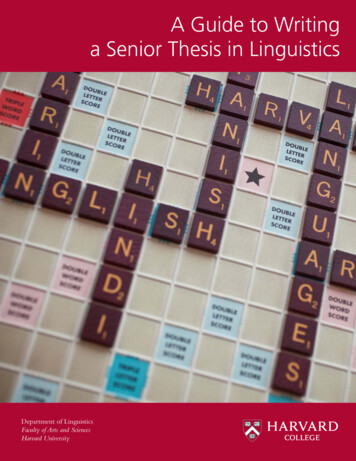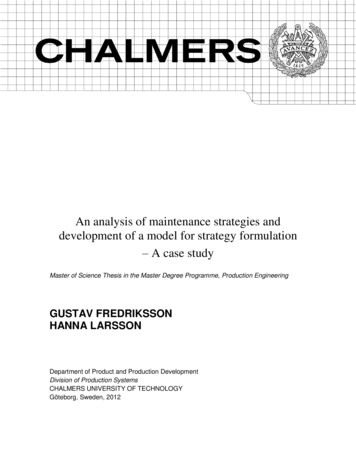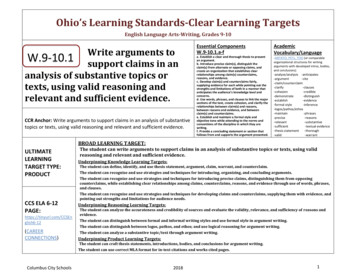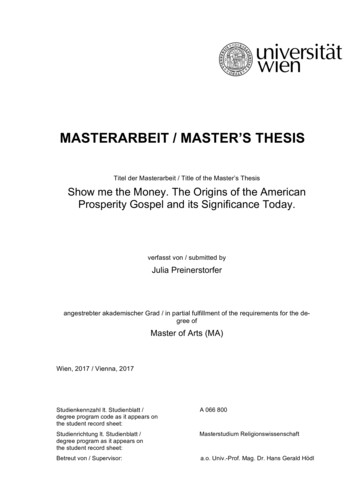
Transcription
MASTERARBEIT / MASTER’S THESISTitel der Masterarbeit / Title of the Master’s ThesisShow me the Money. The Origins of the AmericanProsperity Gospel and its Significance Today.verfasst von / submitted byJulia Preinerstorferangestrebter akademischer Grad / in partial fulfillment of the requirements for the degree ofMaster of Arts (MA)Wien, 2017 / Vienna, 2017Studienkennzahl lt. Studienblatt /degree program code as it appears onthe student record sheet:A 066 800Studienrichtung lt. Studienblatt /degree program as it appears onthe student record sheet:Masterstudium ReligionswissenschaftBetreut von / Supervisor:a.o. Univ.-Prof. Mag. Dr. Hans Gerald Hödl
Contents1.Introduction . 31.1.The Lakewood Church: America’s largest church . 31.2.Outline and structure of this thesis. 82.Defining prosperity gospel . 102.1.Definition of the term. 102.2.The prosperity gospel in the United States and the wider world today . 133.Origins and influences of the modern .prosperity gospel . 173.1.Introduction . 173.2.Christian influences – Pentecostalism, .the Charismatic movement, & faith healing . 173.2.1.Introduction . 173.2.2.Pentecostalism in the world today . 183.2.3.The origins of Pentecostalism - The Holiness Movement . 203.2.4.The beginning of Pentecostalism – From Azusa Street to the .Assemblies of God . 223.2.5.Healing in early Pentecostalism – Sister Aimee McPherson . 273.2.6.The charismatic revival . 293.2.7.Oral Roberts and the healing revival . 323.2.7.1.The healing revival – An overview . 323.2.7.2.Oral Roberts – The “Patriarch of the Prosperity .Gospel” . 343.3.New Thought and the power of the mind . 383.3.1.Introduction . 383.3.2.From Phineas Quimby to Mary Baker Eddy. 383.3.3.From New Thought to self-help culture. 433.4.Self-help culture and The Power of Positive Thinking . 443.4.1.Introduction . 443.4.2.Norman Vincent Peale . 443.4.3.The Power of Positive Thinking . 463.4.4.Healing in The Power of Positive Thinking . 503.4.5.Criticism of Norman Vincent Peale . 513.5.The American Dream . 531
3.5.1.Introduction . 533.5.2.Origin of the “American Dream” . 533.5.3.The narrative of the American Dream . 554.The makers of the Word of Faith Movement . 594.1.Introduction . 594.2.Essek William Kenyon . 604.3.Kenneth E. Hagin . 635.The Word of Faith Movement . 685.1.Introduction . 685.2.Positive confession. 695.3.The promise of health and wealth . 735.3.1.Introduction . 735.3.2.Wealth . 735.3.2.1.The promise of material prosperity . 735.3.2.2.How to give (and receive) money . 785.3.3.Health . 835.3.3.1.The Promise of health . 835.3.3.2.Relationship to medicine. 885.3.4.5.4.Why is it not working?. 90Popular ministries of the The Word of Faith Movement . 925.4.1.Kenneth Copeland . 935.4.2.Creflo Dollar . 945.4.3.Paula White-Cain . 965.5.Criticism of the Word of Faith movement and the .prosperity gospel . 986.Conclusio. 1036.1.The thesis revisited . 1036.2.Final remarks . 1077.Bibliography . 1108.Appendix . 1218.1.English Abstract . 1218.2.German Abstract . 1222
“Beloved, I wish above all things that thou mayest prosper and be in health, evenas thy soul prospereth.”1(3 John 2, King James Version)1. Introduction1.1. The Lakewood Church: America’s largest churchOne of America’s largest churches is the Lakewood Church in Houston, Texas.According to their own count, the church hosts an astonishing 38,000 attendants onany given weekend.2 Although this incredibly high number is based on the church’sown observations, several counts conducted by journalists confirm a similarnumber, estimating between 30,000 and 45,000 per weekend. The megachurch isled by pastor Joel Osteen and teaches a variety of the prosperity gospel theology.3In short, the prosperity message is that God grants true believers material, physical,and spiritual health and wealth.Osteen’s father John founded the Lakewood Church in 1959. Originally, he wasordained as a pastor by the Southern Baptist Convention, but received the baptismof the Spirit 4 at the end of the 1950s. This subsequently led to his leaving hisoriginal denomination and the establishment of his own religious group.5The first meeting of the Lakewood Church took place in a converted feed store,somewhat outside of Houston on Mother’s Day 1959. 6 The church quicklydeveloped a charismatic style. Glossolalia,7 religious ecstasy, and healing were partof the services. John Osteen became rapidly known in the scene and formed close1This and all further Bible quotes refer to the Authorized King James Version, unless otherwiseindicated.2Lakewood Church, “Leadership Team,” accessed August 8, /Leadership-Team.aspx3Rahel Gersch, Frommer Individualismus. Die Lakewood Church und die PhänomeneMegachurch, prosperity gospel und charismatische Pastorenschaft (Berlin: Weißensee Verlag,2013), 7.4See chapter 2.1. of this thesis for a definition.5Gersch, Frommer Individualismus, 118-119.6Lakewood Church, “Our History,” accessed August 8, /Our-History.aspx7“Speaking in tongues refers to a language miracle whereby under the inspiration of the HolySpirit one is able to speak in a language (either human or heavenly) unknown to the speaker.”Quoted from Frank D. Macchia, “Glossolalia,” in Encyclopedia of Pentecostal and CharismaticChristianity, ed. Stanley M. Burgess, 223-225 (New York: Routledge, 2006).3
bonds with other charismatic figures and well-known prosperity theology preachersOral Roberts and Kenneth Hagin.8 During his career as a pastor, Osteen hosted atelevision program which was broadcast in over one hundred countries andauthored forty-five books. He and his wife Dodie led the church until his death in1999, when his son Joel took over.9Joel studied at the Oral Roberts University in Tulsa, where he received his degreein radio and television communications. After finishing his studies in 1982, Osteenreturned to Texas and started working for his father’s church. He established atelevision ministry and produced all of his father’s televised sermons until hisfather’s death.10 Under Joel Osteen’s leadership, the church grew significantly. Hiswork as a pastor as well as his bestselling books and internationally-broadcastedTV presence make him one of the most famous American preachers today.11 Hispopular books can be characterized as religious self-help literature. Titles includeYour Best Life Now: 7 Steps to Living at Your Full Potential; It’s Your Time: ActivateYour Faith, Achieve Your Dreams, And Increase in God’s Favor; and Everyday aFriday: How to be Happier 7 Days a Week. Such books not only increased hispopularity, but also helped Joel Osteen become a millionaire.12In September 2006, the American Time Magazine published a cover story whichanalyzed the rise of the prosperity gospel in the United States. In the article, theauthors use the term “Prosperity Lite” to characterize the theology of the LakewoodChurch and other megachurches of the country. They remark, “while they don’texclusively teach that God’s riches want to be in believers’ wallets, it is a key partof their doctrine.”13An interview with pastor Joel Osteen was a crucial part of the article. When askedabout prosperity theology, Osteen seemingly distanced himself from the term andits associated teachings. “I don’t think I’ve ever preached a sermon about money,”148Gersch, Frommer Individualismus, 119-120. Find more on Kenneth E. Hagin in chapter 4.3. ofthis thesis.9Lakewood Church, “Our History.”10Lakewood Church, “Joel Osteen,” accessed August 8, /Joel-Osteen.aspx.11Gersch, Frommer Individualismus, 7.12Ibid., 122.13David Van Biema and Jeff Chu, “Does God Want You To Be Rich?” Time Magazine,September 10th, 2006, accessed August 8, /0,9171,1533448-2,00.html.14Ibid.4
he explained. As he elaborated however, he made comments that did indeed linkhim and his ministry to some version of the prosperity gospel: “I preach thatanybody can improve their lives. I think God wants us to be prosperous. I think hewants us to be happy. To me, you need to have money to pay your bills. I think Godwants us to send our kids to college. I think he wants us to be a blessing to otherpeople. But I don’t think I’d say God wants us to be rich. It’s all relative, isn’t it?”15Aside from the distancing self-identification of the Lakewood Church pastor, thereof course is another side to the story. Rahel Gersch, a religious studies scholar, hasconducted a qualitative analysis of the Lakewood Church in her doctoral research.She identifies several rites and theological basics that strongly suggest links to theprosperity gospel. Among others, she observed positive thinking and positiveconfession16 as well as a seeding-reaping17 approach towards giving in the servicesof the church—all of which are typical features of the prosperity gospel, which willbe elaborated on in later chapters.An investigation of the Church’s current website supports Gersch’s research. Thesynopsis of one of Joel Osteen’s recent books, Think Better, Live Better, that isadvertised in the “Shop” section of the site, offers one basic principle of theprosperity gospel: positive confession. It highlights the power of the believer’smind and the personal agency one has in leading a good life. With this book, JoelOsteen gives “a simple yet life-changing strategy for erasing the thoughts that keepyou down and reprogramming your mind with positive thinking to reach a new levelof victory.”18 Positive confession is a recurring topic in Joel Osteen’s sermons. Forexample in one from January 2016, which can be watched on the ministry’sYouTube channel, he preaches about speaking the right words— “sowing the rightseeds”—like health or victory, and eventually those aspirations will become real.He also cautions his audience to not sow the wrong seeds–negative things andthoughts–or those things will happen.1915Van Biema and Chu, “Does God Want You.”Gersch, Frommer Individualismus, 183-184.17Ibid., 187.18Lakewood Church, “Think Better, Live Better,” accessed August 8, oduct.aspx?sku JHB0063E.19Joel Osteen, “Your Words Become Your Reality – Joel Osteen,” YouTube video, postedJanuary 7, 2016, accessed August 8, 2017, https://youtu.be/GA6uE2CPo1I.165
Two other aspects at the center of the prosperity gospel are material wealth andphysical health. Both of those topics are also prominently featured on the LakewoodChurch website. It offers information on “Financial Ministry.” It states, “We allneed a plan for our money. You can take control of your money no matter what yourcurrent financial situation is and the Lakewood Financial Ministry is here to help.We have exciting new classes that explore God’s way of handling money. In theseclasses you’ll learn practical, Biblical steps and wisdom to get rid of debt, spendsmart, save wisely and much more!” 20 There is also a “Business Ministry” thatspecifically deals with implementing God’s principles in all business dealings aswell.21Every Tuesday the Church offers the “Financial Peace University,” a class that dealswith financial problems and offers a full plan on everything from budgeting topaying off debt. The class is taught by Dave Ramsey, a financial expert. In addition,there is a Church-specific “Financial Freedom Class” that explains what Godteaches about money and how to implement it in everyday life.22The theme of health is also a well-circulated topic within the Lakewood Church.One example of this can be found in a booklet written by Joel Osteen’s mother,Dodie, called Healed of Cancer. In the synopsis given on the Church’s website,there are references to what Dodie does for believers—she “courageously prays forthe sick, casts out demons, and ministers with tears of compassion to hurtingpeople”23 —as well as reports that many people claim to have been healed as resultof her ministry. There are also short videos on Mr. Osteen’s YouTube channel ofpeople telling their stories of being healed, at least in part, by their faith in God.24Additionally, there are several classes and ministries offered which deal with allkinds of life issues and can be classified within the term self-help: classes on20Lakewood Church, “Financial Ministry,” accessed August 8, .aspx?mid 34.21Lakewood Church, “Business Ministry,” accessed August 8, .aspx?mid 4822Lakewood Church, “Financial Ministry.”23There is no direct link to the booklet, it can be found in the online book store, when scrollingdown. Lakewood Church, “Book Store”, accessed August 8, oks.aspx.24Here is only one example from Joel Osteen’s YouTube Channel: Joel Osteen, “Ana SantiagoFights Cancer Through the Power of Faith,” YouTube video, posted February 21, 2011, accessedAugust 8, 2017, https://youtu.be/ZmFjnkrtxJs.6
marriage and divorce, classes on being a good Christian man, woman, teen or child,as well as courses that deal with substance abuse or being a veteran.25Joel Osteen’s ministry is a very popular example for the prosperity gospel, but byfar not the only one. Other ministries associated with the prosperity message offersimilar courses, materials, products and insights on their websites. On CrefloDollar’s26 website, there is a shop site solely dedicated to finances. You can buybooks or CDs with titles such as God’s Plan for Your Finances or Money DoesMatter and So Does How You Handle It!27 In the section for healing, one can buyHealing 101 or Deliverance from Addiction.28Paula White-Cain, who had the honor of giving the inaugural prayer29 at PresidentDonald J. Trump’s inauguration ceremony in January 2017, is also associated withthe prosperity gospel.30 Whereas she did not make a clear reference to the prosperitymessage in this particular prayer, she offers texts on the matter on her website. Oneexample is a post in which she elaborates on God’s promise of prosperity: “KingDavid declared that God takes pleasure in you prospering. God is not magnifiedwhen you are broke, busted, or disgusted. God is not glorified when you have adream but no resources to fulfill the dream and the desire of your heart. It is God’sdesire that you prosper, but realize that prosperity is not just about finances.”31 She25The events are naturally very regularly updated. Lakewood Church, “Events,” accessed August8, 2017, 6See Chapter 5.4.2. of this thesis for more on Creflo Dollar.27Creflo Dollar Ministries, “Shop – Product Category Finances,” accessed August 8, ces/.28Creflo Dollar Ministries, “Shop – Product Category Healing,” accessed August 8, /page/2/.29A transcript of the prayer she gave is available online: Paula White Ministries, “Paula WhiteCain Inauguration Prayer,” accessed August 8, 2017, n-prayer/.30Julie Zauzmer, “Paula White, prosperity preacher once investigated by Senate, is acontroversial pick for inauguration,” Washington Post, December 29, 2016, accessed August 8th,2017, -inaugurationprayer/.31Paula White Ministries, “Prosperity,” accessed August 8, 2017,http://paulawhite.org/prosperity-184/.7
also offers various DVDs, books and CDs on the topic.32 Paula White-Cain is also“spiritual adviser” to the current president of the United States.33So, the prosperity gospel is far from being only a niche religious phenomenon. Still,there are only a handful of academic books that deal with the movement in detail.This thesis will give an overview on the research available on the prosperity gospelas well as incorporating primary works by prosperity teachers as well as materialavailable via prosperity churches.But what exactly does the prosperity gospel teach? What makes its principles sopopular and accessible? And most of all: how did the modern prosperity gospelcome into being? These are the guiding questions this thesis will answer.1.2. Outline and structure of this thesisIn this thesis the origins, influences, and characteristics of the modern prosperitygospel will be discussed, with a special focus on the so-called Word of Faithmovement. It will be shown that the modern prosperity gospel is, in its essence, atruly American religion, although it has been very successfully exported all overthe world in recent decades. We will see that the history of the modern prosperitygospel is closely connected to religious and cultural phenomena that influencedAmerican society in the late 19th and 20th century.The first part of this thesis will lay the foundation by looking at the definitions ofthe terms we are working with, the prosperity gospel, the Word of Faith movement,the health and wealth gospel, as well as outline some basic facts and figures aboutthe significance of the prosperity gospel in the religious landscape of both theUnited States and the wider world.The second part will closely examine the origins and influences of the modernprosperity gospel. We will separately discuss four large phenomena which had amajor impact on the movement: Christianity, especially Pentecostalism andCharismatic Christianity will be discussed in detail, as well as their respectiveattitude towards healing, with a focus on Oral Roberts. Then we will look at the32For some products, browse through the store on her website: Paula White Ministries,“Products,” accessed August 8, 2017, https://paulawhite.org/products.33Noah Weiland, “Paula White, Trump’s Spiritual Adviser, Says He Has ‘a Hunger for God,’”The New York Times, January 19, 2017, accessed August 8th, pastor-paula-white.html.8
religious movements New Thought and Mind Cure, where we will examinespecifically the power that the mind and thoughts is believed to have over thematerial side of life. Next, we will analyze self-help culture and one work inparticular, The Power of Positive Thinking by Norman Vincent Peale, which greatlyinfluenced the American culture as a whole and the prosperity gospel in particular.Finally, we will look at the American Dream and certain traits of this narrative—like the ideal of upward social mobility—that also supported the rise of theprosperity gospel in the late 20th century.The third part of this thesis will focus on the Word of Faith Movement, which isone of the most popular prosperity gospel variations in the United States today. Wewill introduce Kenneth E. Hagin Sr., who is generally credited with being the“father” of the modern prosperity gospel. Then we will examine three main featuresof the belief system in particular: the doctrine of positive confession and theattitudes towards wealth and health. We will look at frequently cited Bible versesand their interpretation, which are the basis for those beliefs, as well as at works byprosperity preachers and some practices that they use.Finally, in the conclusion we will revisit the origins and influences of the modernprosperity gospel, give a final overview on how it is connected with the Word ofFaith Movement today and explain what is so truly American about this religiousmovement. Perhaps we will find an explanation to why it is so extremely successful.9
2. Defining prosperity gospel2.1. Definition of the termBefore we start to examine the origins and history of the prosperity gospel, we haveto define what we mean by this term.Prosperity gospel is a variety of Protestantism and is not organized in a singledenomination, has no umbrella organization or even a single common theology, butrather is practiced by individual preachers, independent churches and ministries,who “advocate and emphasize slightly different doctrines and practices that areconnected with the health and wealth concerns of Christians.”34 Although it is nondenominational, it has a strong similarity in form and context to Pentecostal andCharismatic Christianity.It shares certain doctrines with these movements, for example the belief in thesecond baptism, which defines the experience of the Holy Spirit as the secondnecessary blessing after conversion. The idea behind this is that “Christ baptizes inthe Spirit to deepen or renew the Christian life.” 35 In Pentecostalism this spiritbaptism becomes “the central metaphor for describing an experience of power forwitness, involving various gifts of the Holy Spirit.”36 The belief in those gifts, orcharismata, is also a typical Pentecostal doctrine that the prosperity gospel shares.These “spiritual gift(s) that were bestowed by the Holy Spirit upon individuals orgroups”37 include speaking in tongues and faith healing.38The one decisive distinguishing and singular characteristic of the prosperity gospelmovement is its unique attitude towards (material) prosperity and physical health.34Martyn Percy, “Health and Wealth,” in Encyclopedia of New Religious Movements, ed. PeterB. Clarke, 236 (New York: Routledge, 2008).35Frank D. Macchia, “Baptism in the Holy Spirit,” in Encyclopedia of Pentecostal andCharismatic Christianity, ed. Stanley M. Burgess, 53 (New York: Routledge, 2006).36Ibid.37Scheper, George L., "Charisma," in Encyclopedia of Religion, ed. Lindsay Jones, 2nd ed. Vol.3, 1549 (Detroit: Macmillan Reference USA, 2005), Gale Virtual Reference Library,go.galegroup.com/ps/i.do?p GVRL&sw w&u 43wien&v 2.1&it r&id GALE%7CCX3424500542&asid 348418357141afb7edc33be78fcea5ee (accessed August 22, 2017).38Faith healing can be defined as the “belief in miraculous healing.” Protestantism historicallybelieved that the era of supernatural healing ended with the apostolic age and only occurred inrare exception. But the rise of Methodism, Holiness and finally Pentecostalism made thisdoctrine prominent again.See Gary B. Ferngren and Darrel W. Amundsen, “Healing and Medicine: Healing and Medicinein Christianity” in Encyclopedia of Religion, ed. Lindsay Jones, 2nd ed. Vol. 6, 3847 (Detroit:Macmillan Reference USA, 2005), Gale Virtual Reference Library,go.galegroup.com/ps/i.do?p GVRL&sw w&u 43wien&v 2.1&it r&id GALE%7CCX3424501306&asid 397d2e5df76e6a4e9c1c1bbd722082fe (accessed August 22, 2017).10
In short, this doctrine says that believers can gain material possessions and goodhealth via the technique of positive confession, “the practice of thinking andspeaking only affirmatively to achieve a desired end.”39 This doctrine has beengranted through the atonement of Jesus and is part of the promise of salvation.To illustrate the variety within the movement we only have to look at the entries onthis topic in religious encyclopedias. In the Encyclopedia of New ReligiousMovements, there are three different articles describing the phenomenon: “Healthand Wealth,”40 “Prosperity Theology”41 and “Word of Faith Movement,”42 all ofwhich touch the subject. In the Encyclopedia of Pentecostal and CharismaticChristianity there are two articles that deal with the subject: “Positive ConfessionTheology”43 and “Prosperity Theology.”44Still, there are useful attempts to narrow the definition of the movement down tosome simple similarities. The Encyclopedia of Pentecostalism and CharismaticChristianity offers this definition:Allowing for differences among various brands, the label ‘prosperitytheology’ typically refers to Christian worldviews that emphasize anearthly life of health, wealth, and happiness as the divine, inalienable rightof all who have faith in God and live in obedience to His commands.4539Milmon F. Harrison, “Word of Faith Movement,” in Contemporary American Religion, ed.Wade Clark Roof, Vol. 2, 786 (Detroit: Macmillan Reference USA, 1999), Gale VirtualReference Library,go.galegroup.com/ps/i.do?p GVRL&sw w&u 43wien&v 2.1&it r&id GALE%7CCX3401300516&asid ca3afa4c42e5d1fe66b2e7e5b649df14, accessed August 24, 2017.See also chapter 5.2. for details on this doctrine.40Percy, Health and Wealth, 235-238.41Simon Coleman, “Prosperity Theology,” in Encyclopedia of New Religious Movements, ed.Peter B. Clarke, 453-455 (New York: Routledge, 2008).42Stephen Hunt, “Word of Faith Movement,” in Encyclopedia of New Religious Movements, ed.Peter B. Clarke, 623-625 (New York: Routledge, 2008).43Dale H. Simmons, “Positive Confession Theology,” in Encyclopedia of Pentecostal andCharismatic Christianity, ed. Stanley M. Burgess, 377-380 (New York: Routledge, 2006).44Rob Starner, “Prosperity Theology,” in Encyclopedia of Pentecostal and CharismaticChristianity, ed. Stanley M. Burgess, 392-397 (New York: Routledge, 2006).45Ibid., 393.11
The Encyclopedia of New Religious Movements focuses on three distinct featuresof prosperity gospel:Prosperity
of victory.”18 Positive confession is a recurring topic in Joel Osteen’s sermons. For example in one from January 2016, which can be watched on the ministry’s YouTube channel, he preaches about speaking the right words— “sowing the right seeds”—like health or vi
